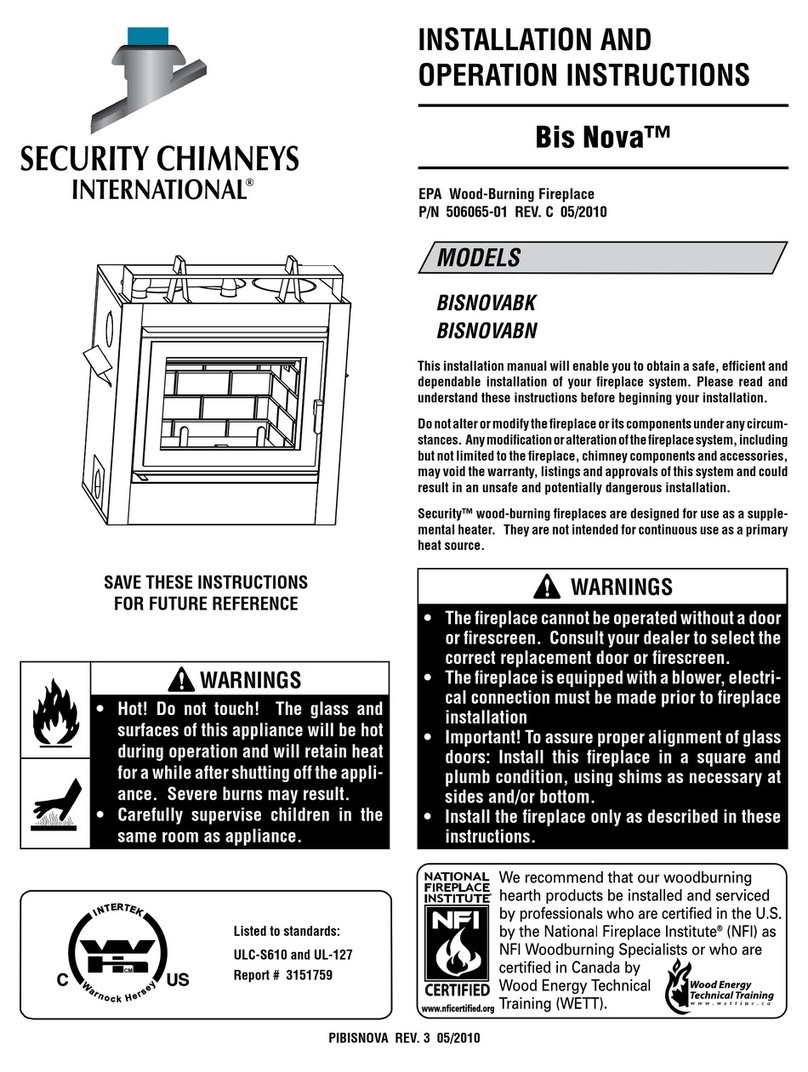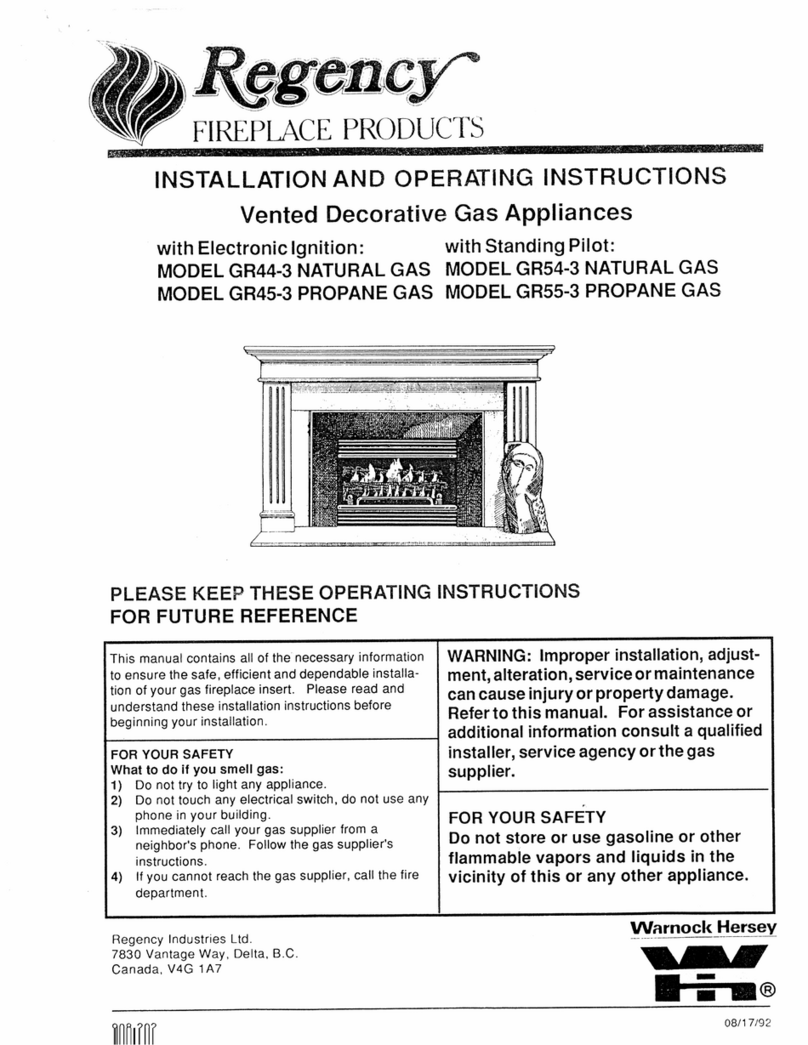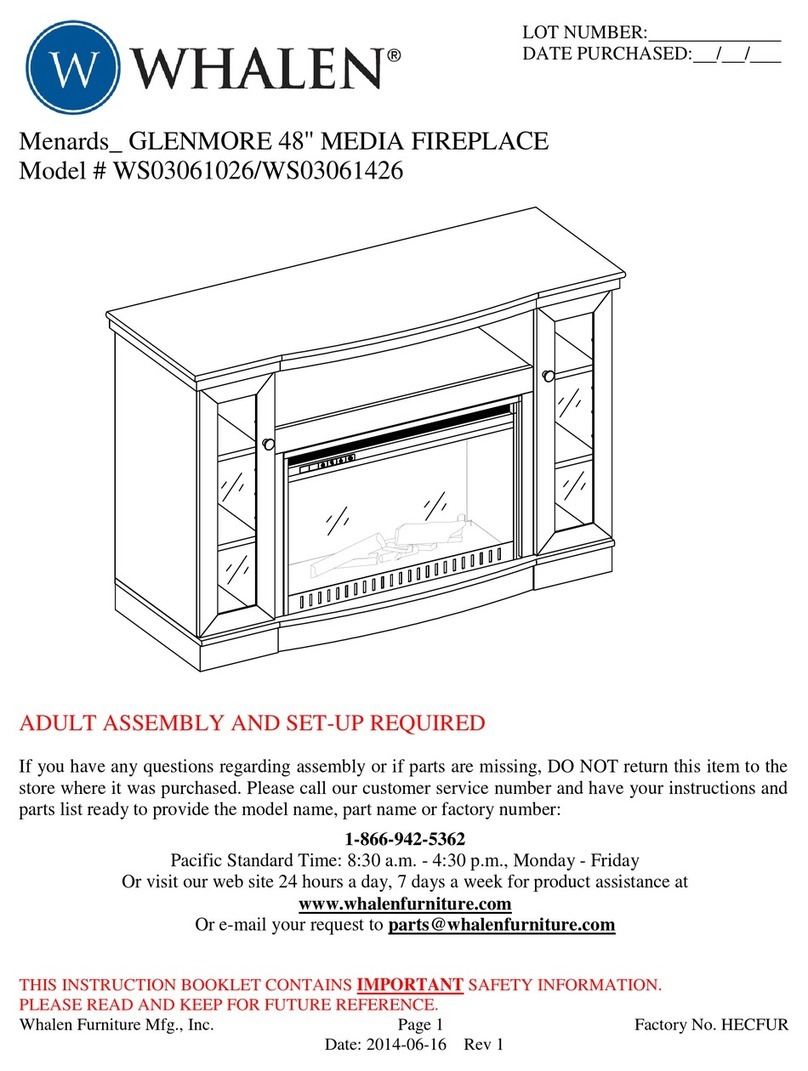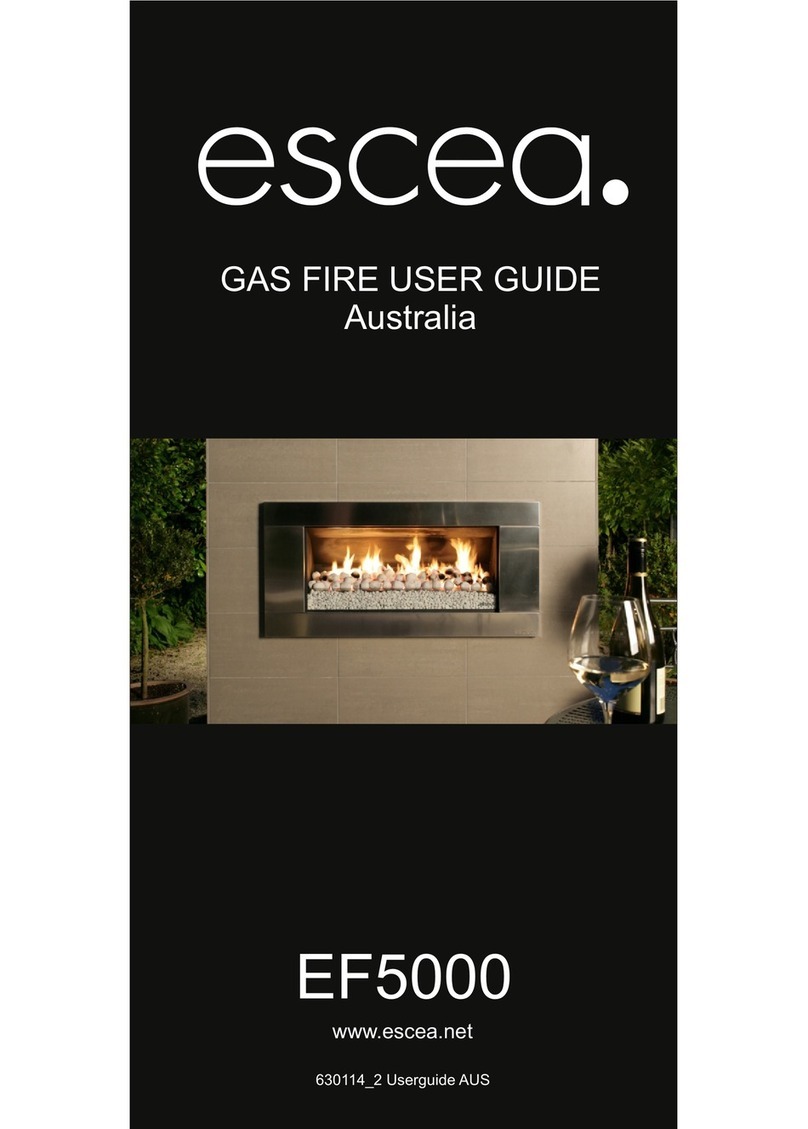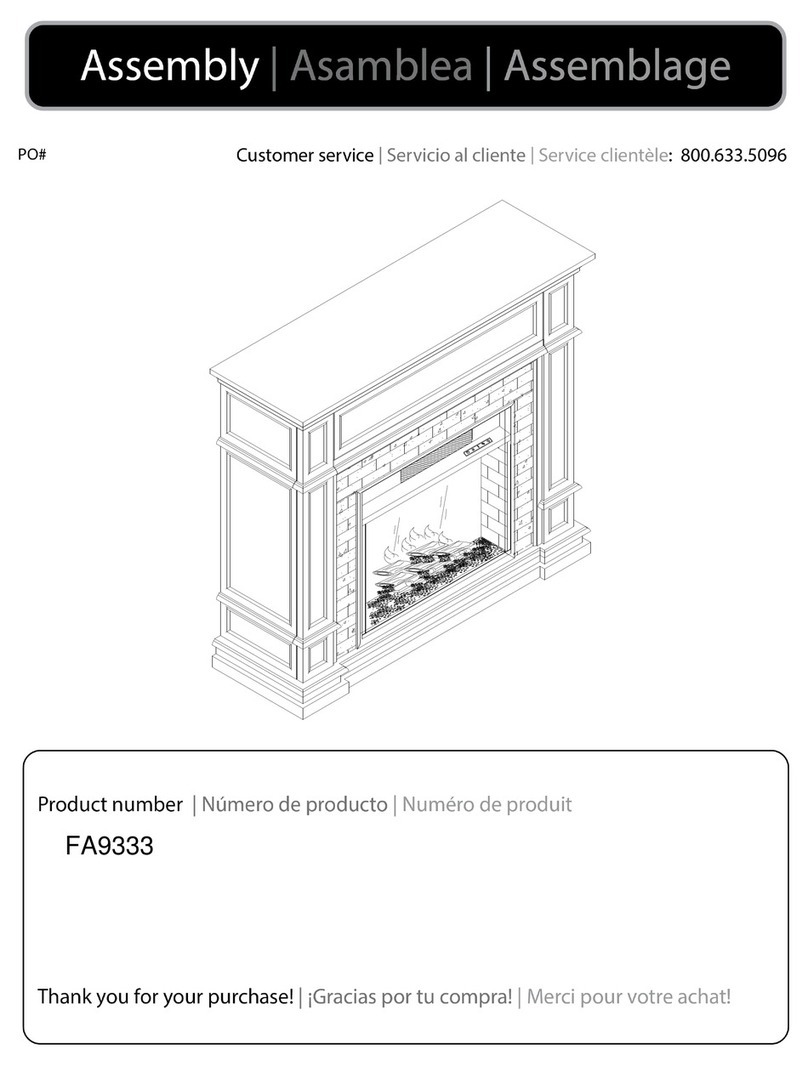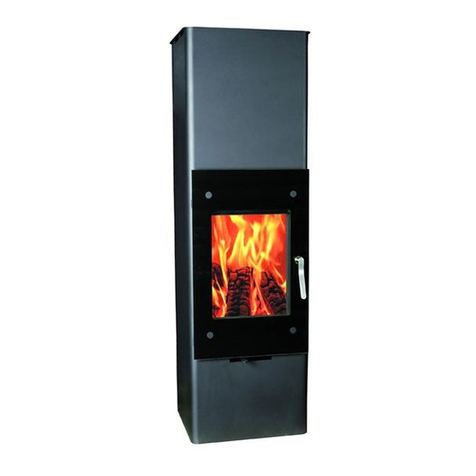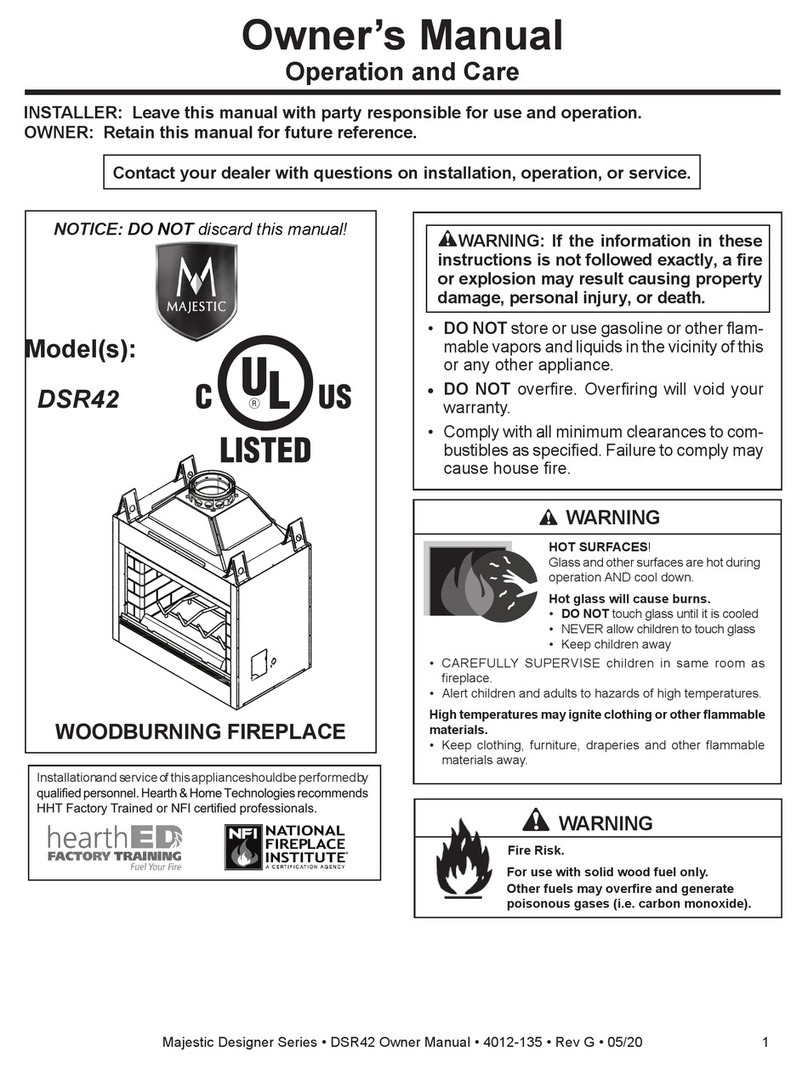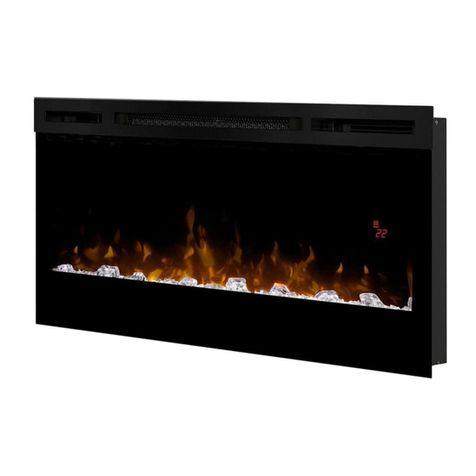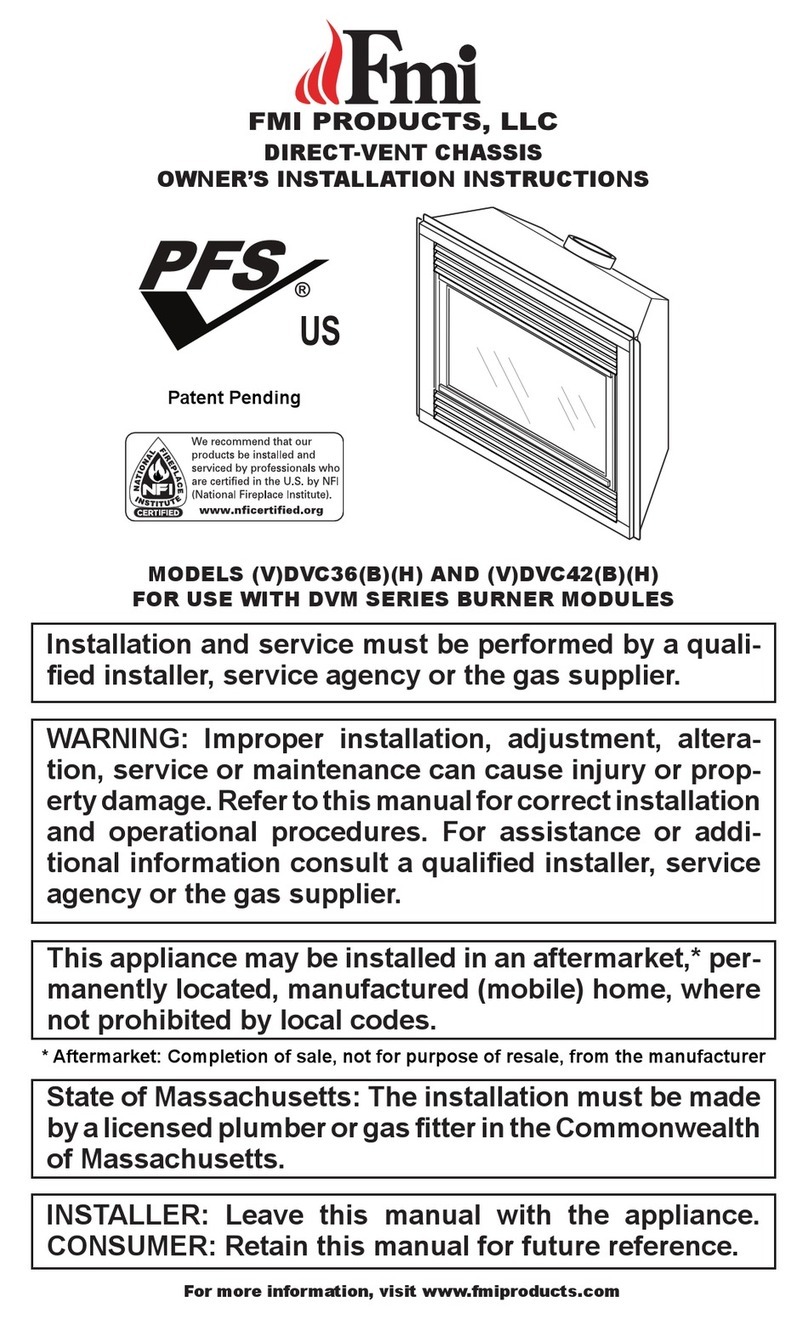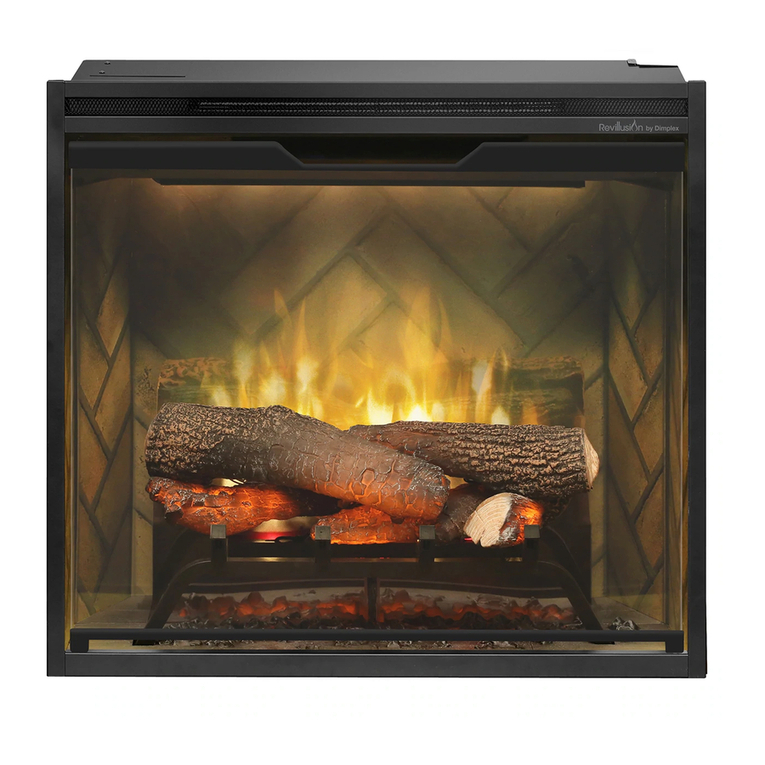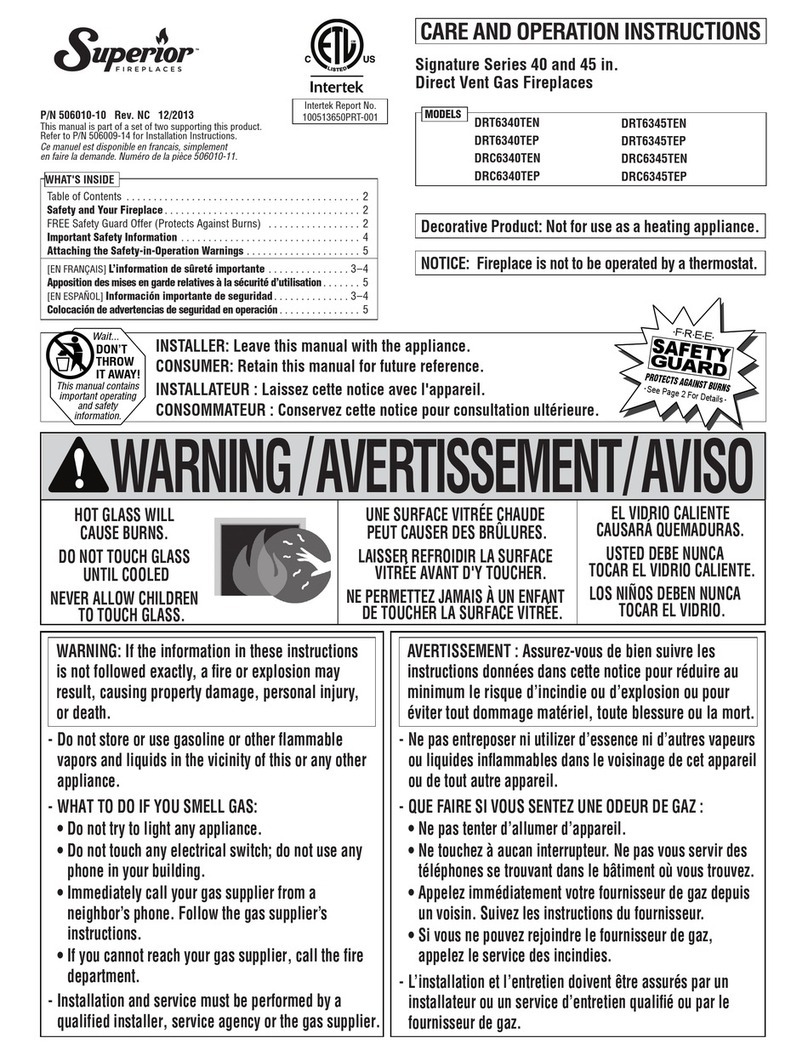Security Chimneys Bis Nova User manual

EPA Wood-Burning Fireplace
P/N 506065-01 REV. D 05/2013
BISNOVABK
MODELS
BIS®Nova
INSTALLATION AND
OPERATION INSTRUCTIONS
WARNING
•The fireplace cannot be operated without a door
or firescreen. Consult your dealer to select the
correct replacement door or firescreen.
• Thereplaceisequippedwithablower,electri-
cal connection must be made prior to fireplace
installation
• Important!Toassureproperalignmentofglass
doors: Install this replace in a square and
plumbcondition,usingshimsasnecessaryat
sides and/or bottom.
• Installthereplaceonlyasdescribedinthese
instructions.
PIBISNOVA REV. 4 05/2013
Thisinstallationmanualwillenableyoutoobtainasafe,efcientand
dependable installation of your replace system. Please read and
understandtheseinstructionsbeforebeginningyourinstallation.
Donotalterormodifythereplaceoritscomponentsunderanycircum-
stances.Anymodicationoralterationofthereplacesystem,including
butnotlimitedtothereplace,chimneycomponentsandaccessories,
mayvoidthewarranty,listingsandapprovalsofthissystemandcould
resultinanunsafeandpotentiallydangerousinstallation.
IHPwood-burningreplacesaredesignedforuseasasupplemental
heater.Theyarenotintendedforcontinuoususeasaprimaryheat
source.
Listed to standards:
ULC-S610 and UL-127
Report # 3151759
SAVE THESE INSTRUCTIONS
FOR FUTURE REFERENCE
WARNING
•
Hot! Do not touch! The glass and
surfacesofthisappliancewillbehot
during operation and will retain heat
forawhileaftershuttingofftheappli-
ance. Severe burns may result.
•
Carefully supervise children in the
same room as appliance.
•
Ifsmallchildrenarepresentinthehome,itis
recommended that this appliance be fitted with
anadjustablesafetygateorbarrierscreen.
DRAFT
5/10/2013
An French manual is available upon request. Order P/N 506065-02.
Ce manuel est disponible en francais, simplement en faire la demande. Numéro
de la pièce 506065-02.

WARNING
Becarefuladdingwoodfueltothe
fireorhandlingfireplacetoolssuch
asshovels,tongsorpokers.
WARNING
The bottom refractory can be
crackedbyexcessiveabusesuch
as tossing heavy logs onto the
grate or gouging with fireplace
tools. Exercise caution when
adding wood to your fireplace.
IMPORTANT! GENERAL SAFETY
PRECAUTIONS. READ AND
UNDERSTAND THESE SAFETY
RULESBEFOREYOURFIRSTFIRE.
IMPORTANT
When burning wood, use SOLID
NATURALDRYWELL-SEASONED
WOODONLY.Hardwoodsarerec-
ommended(softwoodstendtoburn
veryquickly).
• DO NOT burn treated wood,
charcoal, coal, trash, card-
board,driftwood,woodsdipped
intar,Christmastreegreens,
pitch,pinetar,creosote,chemi-
cal chimney cleaners, ame
colorants,polystyrenepackag-
ing, wood products with syn-
thetic binders (i.e. plywood).
Plywood, lumber and other
misc. materials can produce
abnormallyhightemperatures,
sputtering and smoking res
and may contain hazardous
chemicals to treat insects and
fungus.
• Burningunapprovedfuelscan
produce excessive tempera-
tures,beyondthedesigncapa-
bilitiesofthereplaceandmay
produceexcesssparksormay
contain hazardous chemicals.
Burningunapprovedfuelscan
resultinachimneyre,ahouse
re,personalinjury,deathor
lossofproperty.
WARNING
NEVER use gasoline, gasoline-
type lantern fuel, kerosene,
charcoal lighter uid, naphtha,
engine oil or similar liquids to
startor“freshenup”areinthis
replace. Keep any ammable
liquidsasafedistancefromthe
fireplace at all times.
WARNING
Use care when selecting window
treatments for windows located
near the fireplace. Avoid using
combustible flowing window
treatments such as curtains on
nearbywindowsthatareofsuf-
cientlengthtobeblowninfront
ofanopenamewhenthewindow
is opened.
Keepanycombustiblefurniture,
materials or decorative pillows
atleast48"(1219mm)fromthe
frontreplaceopening.
WARNING
Never leave your fireplace unat-
tended while it is burning.
WARNING
THE FIREPLACE MUST BE OPER-
ATED WITH THE DOORS FULLY
OPENEDORDOORSFULLYCLOSED.
IF THE DOORS ARE LEFT PARTLY
OPENED,GASANDFLAMEMAYBE
DRAWN OUT OF THE FIREPLACE
OPENING, CREATING RISKS OF
BOTH FIRE AND SMOKE. IF THE
UNIT IS OPERATED WITH THE
DOORSFULLYOPENED,THEFIRE
SCREEN MUST BE USED.
WARNING
THIS FIREPLACE HAS NOT BEEN
TESTED WITH AN UNVENTED GAS
OR A FIREPLACE INSERT. TO
REDUCERISKOFFIREORINJURY,
DO NOT INSTALL AN UNVENTED
GAS LOG SET OR FIREPLACE
INSERT OR OTHER PRODUCTS
NOT SPECIFIED FOR USE WITH
THIS FIREPLACE.
WARNING
Never leave children unattended
when there is a fire burning in the
fireplace.
WARNING
To avoid the risk of damaging
fireplace materials and increas-
ingtheriskofre,donotusethe
replacetocookorwarmfood.
WARNING
Neitherthemanufacturernorthe
seller warrants “smoke free”
operation nor are we respon-
sibleforinadequatesystemdraft
causedbymechanicalsystems,
generalconstructionconditions,
inadequate chimney heights,
adverse wind conditions and/or
unusualenvironmentalfactorsor
conditions beyond our control.
WARNING
Always ensure that the air inlet to
thereplaceisfreefromdebris
and any other obstructions that
canblocktheentranceofair.
WARNING
Nevermodifyoralteryourreplace
system in any way. To do so may
create a potential fire hazard and
void the limited warranty,listings
andapprovalsofthissystem.
LOCATING THE NAME PLATE
The name plate has been attached to a chain located
inside the front opening below the door. To locate it,
simply place your hand into the center of the opening
and slide it to the right. Locate the chain and pull on
it to access the name plate.
2

TABLE OF CONTENTS
SAFETY RULES.................................Page 2
Locating the Name Plate ...................Page 2
Introduction ......................................Page 3
Parts Required .................................Page 3
Optional Equipment...........................Page 3
Operating The BIS®Nova Fireplace...Page 3
Fuel ...................................................Page 3
Starting And Maintaining A Fire ........Page 4
Combustion Control .........................Page 4
Refueling For Best Performance .......Page 4
Smoking – Causes And
Troubleshooting ..............................Page 4
Important Cautions ...........................Page 5
Maintaining Your
BIS Nova Fireplace .....................Page 5
Creosote............................................Page 5
Chimney Maintenance.......................Page 5
Dealing With A Chimney Fire.............Page 5
Top Baffle Removal ...........................Page 5
Finish Door Casing Care....................Page 5
Disposing of Ashes ...........................Page 6
Refractory Installation.......................Page 6
Door Removal...................................Page 6
Door Adjustment...............................Page 6
Glass Care - Replacement.................Page 7
Glass Care - Cleaning........................Page 7
Gasket Replacement ........................Page 7
Fireplace Installation ........................Page 7
Locating The BIS Nova Fireplace.......Page 7
Optional Cast Facade Installation ......Page 8
Hearth Extension Requirements .......Page 8
Framing, Facing And Mantel..............Page 9
Fireplace Blower................................Page 11
Hot Air Ducting Installation ..............Page 11
Gravity Kit .........................................Page 11
Central Forced Air Kit ............................Page 12
Outside Air Kit ..................................Page 13
Chimney System...............................Page 14
Chimney Installation Notes ...............Page 14
Chimney Installation Instructions......Page 15
Offset Chimney Installation ...............Page 16
Angled Wall Radiation Shield ............Page 19
Chimney Support Installation............Page 19
Chimney Chase And
Multiple Terminations......................Page 19
Masonry Application Instructions .....Page 20
Installation Accessories ....................Page 21
Replacement Parts............................Page 22
Specifications....................................Page 22
Clearance to Combustibles ...............Page 22
Chimney Components Lists ..............Page 23
Product Reference Information.........Page 26
THE FIREPLACE
INTRODUCTION
The BIS
®
Nova wood-burning fireplace is an
energy efficient, heat circulating, closed com-
bustion fireplace. You will receive a lifetime
of comfort and enjoyment from your fireplace
provided it is installed, maintained and oper-
ated properly.
• Please read these instructions and retain
this manual for future reference.
• Before beginning the fireplace installation,
consult the local authorities to obtain your
building permit and check your localbuilding
codes. Install the fireplace only as described
in these instructions and using only IHP
components.
• ThisreplacehasbeentestedforCAN/ULC
S610-M87andANSI/UL127underreport
number 3151759. It has also been tested
for EPA 40 C.F.R Part 60, section 60.532(b).
Certificate number 706.
• The BIS Nova fireplace is NOT intended for
use with a gas log set. Do not use a fireplace
insert or any other product with this fireplace
unless it is specified by IHP for use with this
appliance. Failure to follow these instructions
will void the certification and the warranty
of the fireplace and may result in an unsafe
installation.
• Theseappliancesaredesignedtoprovide
supplemental heat to the immediate area
only. Therefore, it is advisable to have an
alternate heat source when installed in a
dwelling.
• These appliancesarenotapprovedfor
Manufactured Home installations.
PARTS REqUIRED
Fireplace Model BIS NOVA
• 6” diameter chimney
*
- Model ASHT+,
S-2100+, HT6000+, HT6103+ or AC
manufactured by Security Chimneys Inter-
national™ only.
OR
• 7”diameterchimney
*
- Model ASHT and
HT6103 manufactured by SecurityChimneys
International™ only.
6” and 7” Chimneys Includes:
- Chimney lengths
- Elbows (where necessary)
- Associated components as per these
installation instructions
•Decorative Door (included in the fireplace)
• UZY6blower(Includedw/Fireplace)
OPTIONAL EqUIPMENT
Order Separately - See Pages 21 and 22
• AdditionalEquipment(optional)
- AC Chimney Starter Section
*
and
AC Chimney
*
- Outside Air Kit
(required if using AC Chimney)
- Chimney Adaptor 7 inch (6AW7
*
)
(If you choose to use 7 inch ASHT
*
or
HT6103
*
chimney)
- Gravity Venting System
- Rigid Firescreen
- Forced Air Kit
u
- Cast Facade Kit
- Blower Speed Control (VRUW)
- Blower Thermodisc Heat Switch
Control (VTU)
- Outside air kit
u
Not tested under EPA certification. If in-
stalled, this appliance no longer qualifies
for EPA certification.
OPERATING THE BIS®NOVA FIREPLACE
Fuel
USESOLIDNATURALWOODFUELONLY.The
BIS Nova fireplace is designed to work best
when fueled with dry seasoned natural wood
only. Hardwoods are preferred to softwoods
since the energy content of wood is relative to
its density. Hardwoods will result in a longer
burning fire and less frequent refueling. A
moisture content of 15% to 20% (seasoned)
is recommended. Wood that has been cut and
split and let to dry under a cover for a period
of one year will usually meet that criteria.
The
required drying time will vary depending on the
climate. Wood that is packed tight together will
take longer to dry. Seasoned wood is darker in
color than wet wood and will have visible cracks
in the grain on the ends.
Excessively wet wood
will be difficult to burn and will result in lower
efficiency, increased creosoting and deposits on
the glass and in the chimney. Excessively dry
wood will burn well but will also have higher
emissions and shorter burning time.
Do not burn scrap or garbage, treated wood or
wood such as driftwood from the ocean which
has been exposed to salt or other chemicals.
Salt or chemicals can corrode the firebox and
chimney. Do not burn large amounts of paper,
cardboard, Christmas tree branches or building
construction materials. Intense firing with these
materials may overheat the fireplace, causing
damage to the unit, a fire or even possibly ignit-
ing a chimney fire if the chimney is creosoted.
Burning unapproved fuel, resulting in excessive
pollutants being emitted, may be prohibited and
subject to a fine or other penalty by the authority
having jurisdiction in your area.
Processed firelogscan be used. Useonly firelogs
that have been evaluated for the application
of fireplace and refer to firelog warnings and
caution markings on packaging prior to use.
CONGRATULATIONS!
When you purchased your new fireplace, you joined the ranks of thousands of individuals
whose answer to their home heating needs reflects their concern for aesthetics, efficiency
and our environment. We extend our continued support to help you achieve the maximum
benefit and enjoyment available from your new fireplace.
Thank you for selecting a IHP fireplace as the answer to your home supplemental heat-
ing needs.
*Available from Security Chimneys™
3

First Fires
Beforeusingthereplacemakesuretoremove
the plastic wrapping and EPA label on door.
Remove anyglueresidueleftbythelabel
using mild soap.
Therstveorsixresshouldbesmallres
ofshortduration(about30to60minutes).
This will help cure the refractory bricks.
During
the first few fires of this appliance there may
be some odor and smoke due to the curing of
the paint, dust accumulation and burning off of
lubricantsused in the manufacturing process
. It
may set off a smoke alarm located in the same
room. For this reason the room should be well
ventilated for the first few fires.
Building a Fire
(startingandmaintainingare)
To start a fire, place several crumpled up balls of
newspaper in the firebox. Place small dry pieces
of kindling on top of the paper, criss-crossing
the kindling so that there are air spaces in be-
tween. Keep the fuel far back enough so that air
can get underneath. Open the air controls fully
and light the newspaper. Once the newspaper
and the kindling is well ignited, close the door.
Once the kindling fire is well established, cord
wood can be added (see Primary Air Combus-
tion Control section for proper operation of the
air controls).
The unit will burn best with 1-2 pieces of cord
wood spaced 1 to 2 inches apart and allowing air
to get under the fuel. Criss-crossing or arrang-
ing the fuel so that air can get underneath, will
help the fire to get started easily. The unit should
be operated with the air control fully open long
enough to get the cord wood well ignited.
COMBUSTION CONTROLS
Primary Air and Air Boost Controls
There is no flue damper in the BIS®Nova
fireplace. As is common with air tight stoves,
the combustion air control sets the flow of air
entering the firebox. This allows for a more
precise control of the fire. The combustion air
control is located below the door on the left side.
The main source of air (primary air) entering
For instance, a long chimney will necessitate
closing the damper more. To obtain the proper
combustion, close the damper completely, then
openitabout1/4”to1/2”(6.4mmto13mm).
Two medium size pieces of wood should be
burning on a bed of hot coals. The heat output
will be approximately 25,000 BTU per hour and
the loading time will be about every 3-4 hours.
Softwoods may be burned using this method
but the time will be substantially reduced.
Slow Combustion
When the air combustion control is completely
closed, thefireplace isin aslow combustionphase.
If the hearth is hot enough, slow combustion will
not extinguish the fire, but there will be a notice-
able change in the flame pattern. The flames will
be slow and may appear dirty if the wood is too
wet (moisture content of 20% and more). Do not
allow the wood to burn without flame, since this
will produce excessive creosote in the unit.
Creosote may accumulate on the glass door.
This method of burning should be used only
after operating the BIS Nova fireplace with the
air control opened to produce a hot fire for
about an hour or at medium pace for at least
three (3) hours. Slow combustion can be used
at night in order to reduce the heat output and
to prolong the burn. The loading time will be
between 6-8 hours.
REFUELING FOR BEST PERFORMANCE
The BIS Nova fireplace will operate best if at-
tention is given to operating the unit with the
damper fully opened after refueling in order
to bring the firebox and the chimney system
up to their optimum operating temperature.
Combustion efficiency is relative to firebox
temperature. A temperature of 500º C (932º F)
and up, with a visible flame, in the upper part
of the firebox indicates a maximum efficiency.
To obtain this temperature, the fireplace must
be operated with the primary air and air boost
controls fully opened during 10 to 20 minutes
after reloading, depending on the heat and on
the moisture content of the wood.
Once you have reachedthe desired temperature,
the air boost can be closed and the primary air
set to a medium setting. You know you have
reached the desired temperature when, closing
the primary air control, you can see a flame
at the top of the firebox. The benefit of this
technique will be cleaner glass, less creosoting,
greater efficiency and the most pleasing fire for
your enjoyment.
SMOKING –
CAUSES AND TROUBLESHOOTING
To reduce the likelihood of smoking when open-
ing the door, set the combustion air controls to
the left before opening the door. Your fireplace
has been designed and tested to provide smoke
free operation. Occasionally, there may be a
small amount of smoking upon lighting the fire,
until the chimney heats up but this should not
continue. If the fireplace continues to smoke it
is probably for one of the following reasons:
Figure 1
Combustion Air Register
Open Closed
Push to Close
Air Boost
Pull to Open
Air Boost
the firebox can be diminished by moving the
air combustion control from left to right. The
primary air is fully opened when the air control
is completely moved to the left. The air control
device can also be used to add an extra boost of
air especially during fire start up and reloading
of the unit.
Pulling the air combustion control will inducean
air boost at the base of the fire allowing an easier
fire start up. When the fire is well established,
the control can be pushed in to shut down the
air boost allowing for a longer burn time. The
combustion air control should be in the closed
position (primary air and air boost) when the
fireplace is not in use. This will minimize air
leakage up the chimney. The combustion air
control should be opened before opening the
door to minimize the possibility of back draft
coming into the room.
Accelerated Combustion
The maximum heat output for the BIS Nova
fireplace is achieved by burning with the door
closed and the combustion air opened. By this
method, the BIS Nova fireplace can produce the
maximum BTU of heat per hour. However, it will
be necessary to reload with wo od every one
or two hours. This is the least efficient method
of burning the BIS Nova fireplace.
Use caution when firing with the combustion
air control wide open. Only burn cord wood in
this manner. Small dry pieces of softwood and
construction scraps will burn very intensely us-
ing this method and may damage the firebox.
Medium Combustion
This is the recommended mode of operating
the BIS Nova fireplace and should be the one
normally used since it will deposit the least
amount of creosote on the glass and in the
chimney. The combustion air control must be
3/4closedandpushedintoclosetheairboost.
The precise setting will depend on many fac-
tors, including chimney length and the moisture
content of the wood.
4
NOTE: DIAGRAMS & ILLUSTRATIONS ARE NOT TO SCALE.

A. Negative pressure in the house
As the fire burns, air goes up the chimney.
This air must be replaced through leakage
into the house or through the outside air duct
(optional). When operating the BIS
®
Nova
fireplace, open a nearby window temporarily
to check if there is adequate replacement air
supply.
B. Fansoperating(e.g.:rangehood)
These fans draw air out of the house and
may actually cause a negative pressure in the
house. Turn off all fans and open a nearby
window to determine if this is the cause of
the problem.
C. Wet wood
Wet or tarred wood will smoulder and smoke
instead of burning properly. Your dealer
can help you determine if you have properly
seasoned wood for burning.
D. Dirtyorblockedchimney
Check to make sure the chimney is clear and
clean. If dirty call a certified chimney sweep
or use a properly sized chimney brush to
clean.
E. Chimney not long enough
The minimum chimney height is twelve
(12) feet (3.7 m) not including the fireplace
height. The chimney must extend at least
three (3) feet (915 mm) above its point
of contact with the roof and at least two
(2) feet (610 mm) higher than any roof or
wall within ten (10) feet (3 m) of it. When
installed with offsets, the minimum chimney
height is fifteen (15) feet (4.6 m). Additional
height will increase draft and will decrease
the tendency to smoke.
F. Poorchimneydraft
With no fire, there should be sufficient draft to
exhaust cigarette smoke introduced under the
baffle. Chimneys installed against an outside
wall without protection or a basement installa-
tion may generate back draft problems which
will cause start-up problems. To prevent this,
open a nearby window, roll up a piece of paper
and light it. Then, hold it in the upper part of
the firebox to warm up the chimney. Wait until
the draft is sufficient, then start the fire.
IMPORTANT CAUTIONS
A.Donotblockthehotairventstothere-
place as this will cause the fireplace to
overheat.
B.Neverusegasoline,gasoline-typelantern
fuel,kerosene,charcoallighteruid,or
similarliquidstostartor‘freshenup’are
inthisreplace.Keepallsuchliquidswell
awayfromthereplacewhileitisinuse.
C. Do not burn coal. The sulphur in coal will
corrodethereboxandchimney.
D.Do
not
burn
driftwood
which
has
been
in
the
ocean or salt water. The salt will corrode
thereboxandchimney.
E.Donotburnwoodintheareainfrontofthe
grate.
F. Donotabusetheunitbyburningpaper,or
cardboard or construction material such as
pressedwood,plywoodorlumber.
G. Do not allow the wood to smoulder or burn
withoutame,sincethiswillproduce
excessivecreosoteintheunitaswellas
increased particulate emissions.
MAINTAININGYOURBIS®NOVA
FIREPLACE
Creosote-FormationandNeedforRemoval
When wood is burned slowly, it produces tar
and other organic vapors, which combine
with expelled moisture to form creosote. The
creosote vapors condense in the relatively
cool chimney flue of a slow-burning fire. As
a result, creosote residue accumulates on the
flue lining. When ignited this creosote makes
an extremely hot fire.
The chimney shall be inspected at least twice
a year during the heating season to determine
when a creosote buildup has occurred.
When creosote has accumulated it shall be
removed to reduce the risk of a chimney fire.
When the creosote accumulation is large, a
creosote fire in the chimney can damage the
chimney and overheat the surrounding wood
framing. Creosote formation in a chimney can
be minimized by making sure there is always
visible flame burning, avoid smouldering fires
and by proper refuelling techniques.
Chimney Maintenance
Regular chimney inspection and maintenance
combined with proper operation will prevent
chimney fires. Keep your chimney clean. Do not
allowmorethan1/16”(1.6mm)creosotebuild
up in your chimney. The amount of creosote will
depend on variables such as frequency of use
and type of fire. We recommend that you:
A. Initially inspect the chimney system weekly.
From this, you will learn how often it will be
necessary to clean your chimney.
B. Have your chimney cleaned by a qualified
chimney sweep. If you wish to clean it
yourself, we recommend using a stiff plastic
or non-metallic brush. If a metal brush is
used, its size should be slightly smaller than
the flue to avoid damaging the chimney. Do
not use a brush that will scratch the stainless
steel interior of the chimney.
C. Do not expect chemical cleaners to keep
your chimney clean. The rain cap can be
removedforinspectionand/orcleaningof
the chimney.
Dealing With a Chimney Fire
Regular chimney maintenance and inspection
can prevent chimneyfires. If you havea chimney
fire, follow these steps:
1. Close the fireplace door and the combustion
air controls.
2. Alert your family of the possible danger.
3. If you require assistance, alert your fire
department.
4. If possible, use a dry chemical fire extin-
guisher, baking soda or sand to control the
fire. Do not use water as it may cause a
dangerous steam explosion.
Finish Door Casing Care
Use a glass cleaner and a soft cloth to polish
the casing. Do not use abrasives such as steel
wool, steel pads or an abrasive polish for they
may scratch the casing’s finish.
5. Check outside to ensure that sparks and hot
embers coming out of the chimney are not
igniting the roof.
6. Do not use the fireplace again until your
chimney and fireplace have been inspected
by a qualified chimney sweep or a Fire
Department Inspector.
Top Bafe Removal Prior to Cleaning The
Chimney
Before starting to clean your chimney, we
recommend that you remove the top baffle to
avoid creosote dust collection at the top of the
baffle. Follow these steps to set the top baffle
out of the way:
1. Slide the front baffle to the front of the
unit.
2. Lift the back baffle and slide it over the front
baffle
You now have access to the chimney
Figure 2B - Top Baffle Removal
Figure 2A - Top Baffle Removal
5
NOTE: DIAGRAMS & ILLUSTRATIONS ARE NOT TO SCALE.

REFRACTORYREPLACEMENT
The intense heat of the fire will normally cause
hairline cracks in the refractory. These cracks
can be minimized by proper curing as described
in “First Fires”. They will not normally dimin-
ish the effectiveness of the refractory. If large
cracks develop, then the refractory should be
replaced. To replace the refractory bricks, follow
these steps (see Figure 3):
1. Remove the bottom refractory
2. Remove the front refractories
3. Remove the left side refractory
4. Remove the right side refractory
5. Remove the back refractory
6. Remove the front ceramic baffle
7. Remove the rear ceramic baffle
To install the new refractories, follow the above
steps in reverse.
Figure 3
DOOR REMOVAL
To remove the door, simply pull the door up from the hinges (see Figure 4). The door adjustment
has been set at the factory. If the fit is still not perfect, you can adjust the door using the hinge
screws.
DOOR ADJUSTMENT
The door may need to be adjusted to be completely airtight. The gaskets’ air-tightness can be
adjusted using two adjustment screws located on the right side of the fireplace facade (An Allen
key#1/8–notsupplied-willbenecessaryforthisadjustment).
CheckingDoorSeal
A one-inch strip of paper may be used to perform a test of the integrity of the door seal. Close
the door on the paper in at least eight points. It is normal to feel only a slight amount of friction.
The door gasket does not need to be “tight” in all areas, since a small amount of leakage is not
hazardous or detrimental to the performance of your fireplace.
Figure 5
Door Installation
WARNING
•
UseonlyaIHPglassdoors,specicallydesignedfortheBISNova
fireplace.
•
The fireplace cannot be operated without door or firescreen. Consult
your dealer to select the correct replacement door or firescreen.
•
Important!Toassureproperalignmentofglassdoors:Installthis
replaceinasquareandplumbcondition,usingshimsasnecessary
at sides and/or bottom.
1
6
Hinges Adjustment
Gasket
Adjustment
Screw
DISPOSING OF ASHES
Remove ashes only when the fire is out and
the ashes are cold (24 to 48 hours after the
fire is out).
Do not leave the ashes in the house as they give
off carbon monoxide and other toxic gases.
WARNING
DisposalofAshes:Ashesshould
be placed in a steel container
with a tight fitting lid and moved
outdoors immediately. The
closedcontainerofashesshould
be placed on a non-combustible
oororonthegroundwellaway
fromallcombustiblematerials,
pending nal disposal. If the
ashesaredisposedofbyburial
in soil or otherwise locally dis-
persed,theyshouldberetained
in the closed container until all
cinders have thoroughly cooled.
1.BottomRefractory
2.FrontRefractories
3.LeftSideRefractory
4.RightSideRefractory
5.BackRefractory
6.FrontCeramicBafe
7.RearCeramicBafe
2
3
5
4
7
Figure 4
6
NOTE: DIAGRAMS & ILLUSTRATIONS ARE NOT TO SCALE.
NOTE: DIAGRAMS & ILLUSTRATIONS ARE NOT TO SCALE.

If possible, you should choose a location where
the chimney will pass throughthe house without
cutting floor or roof joists (see fireplace dimen-
sions Page 9).
Usually, no additional floor support is needed
for the fireplace. The adequacy of the floor
can be checked by first estimating the weight
of the fireplace system. Weights are given
on Page 23. Note the floor construction and
consult your local building code to determine
if additional support is needed.
The BIS Nova fireplace may be installed
directly on the floor or on a raised base (for
proper guidelines, refer to “Hearth Extension
Requirements”) and a minimum of 6’8” (2 m)
measured from the base of the appliance to the
ceiling is required.
When selecting the location, the chimney outlet
position and the direction of the wind are impor-
tant factor affecting the chimney performance.
To allow a maximum draft and to reduce wind
turbulence, the chimney must:
• Penetratethehighestpartoftheroof.
• Beinstalledasfaraspossibleofroofoffsets,
trees or any other obstructions that may
cause wind turbulence and back drafts in
the chimney.
• Theleastamountofoffsets(elbows)pos-
sible. NOTE: A maximum of 2 offsets is
allowed.
GLASS CARE
Glass Replacement
The glass used for the BIS
®
Nova fireplace is
ahightemperatureceramicglass(1,400°F/
760° C). If the glass breaks, it must be replaced
with an identical ceramic glass. Tempered
glass or ordinary glass will not withstand the
high temperatures of the BIS Nova fireplace.
Replacement glass should be purchased from a
IHP dealer (see “Replacement Parts”, Page 23).
DO NOT OPERATE THE UNIT WITH CRACKED
OR BROKEN GLASS.
Glass Cleaning
The BIS Nova fireplace is designed to keep the
glass clean under normal operating conditions.
If the BISNova fireplace is operated continuously
with the combustion air controls closed, the
glass will tend to get dirty unless thefuel, firebox
and glass are maintained at hot temperatures
(see “Refueling For Best Performance”). To
clean the glass, there are a number of specially
designed cleaners. Your IHP dealer can recom-
mend a suitable cleaner which is available in
your area. Regular household glass cleaners
will not clean creosote. Do not use abrasives
suchassteelpads,steelwoolorovencleaner
as they will scratch the glass.
DO NOT USE CHEMICAL GLASS CLEANERS
ON PAINTED SURFACES ASITMAY CAUSE
THE PAINT TO PEEL.
CAUTION : DO NOTALLOW WINDOW CLEANER
TO GET IN CONTACT WITH DOOR GASKET OR
PAINTONFACADEORDOOR.ONCECLOSED,
CONTACT OF GLASS CLEANER WITH THE
FIREPLACE FACADE CAN PROVOKE PAINT
PEELING OFF.
Gasket Length* Dimensions Part No.
Around
Glass
69
(1753)
1x3/16
(25 x 4.8) PR-SR1685H
On Door
Frame
73
(1854)
3/4dia
(19.5) PR-SR1823O
Table 1
* NOTE: Inches (millimeters)
FIREPLACE INSTALLATION
Locating The BIS Nova Fireplace
The best location to install your fireplace is
determined by considering the location of
windows, doors, and the traffic flow in the room
where the fireplace is located, allowing space
in front of the unit for the hearth extension and
the mantel, and taking into consideration the
location of the hot air ducts (optional), outside
air kit (optional) and chimney.
GasketReplacement
Remove the door from the unit (see Page 6)
and lay it on a clean unabrasive surface. To
replace the gasket, first remove all of the old
gasket and gasket cement. Make sure that the
surface is totally clean before applying new
cement (a high temperature silicone caulking
rated at 500° F [260° C], is suitable) or adhesion
problems may result. Apply gasket cement to
the gasket channel and install the new gasket.
This replacement partis available from your IHP
dealer in the following dimensions:
Marginal Location
Wind Direction
Location
Not
Recommended
OutsideAirIntake
Facing the Wind
Location
Not
Recommended
Location Recommended
Figure 6
7
NOTE: DIAGRAMS & ILLUSTRATIONS ARE NOT TO SCALE.
NOTE: DIAGRAMS & ILLUSTRATIONS ARE NOT TO SCALE.

Figure 7B
Optional Cast Facade installation
Install the Facade per instructions provided
in Facade Kit (ordered separately - see Page
21).
Framing,FacingAndMantel
The construction of the framing, facing, and
mantel must be in accordance with the stan-
dards and the following illustrations (Figures
8 and 9):
A. Frame the fireplace using 2” x 3” or heavier
lumber.
B. WARNING: Combustible materials can-
not be used in the space directly above
thereplace,exceptforthestudsabove
thefacadethatsupportthefacingand
mantel. This area must remain empty
foraheightof6’8”(2,032mm) mea-
suredfromthebaseoftheappliance.
C. Frame the fireplace with vertical studs at the
sides of the fireplace running from floor to
ceiling (see Figure 8). If combustible facing
is to be used, position the studs back, from
the front edge of the fireplace (a space that
is the thickness of the facing material, so
that the facing can be installed flush with the
fireplace facing). Frame headers between
the vertical studs only as follows:
• Place 2” x 3” or 2” x 4” headers,
only along the upper part of the front,
side and back faces (some codes
may require a 2” x 6” on an outside
bearing wall). Do not put wood or
any combustible material within the
area above the fireplace except on the
front facing.
• Placeheadersonlyasrequiredtosup-
port the facing and mantel.
D. WARNING: The fireplace must not be in
contact with any insulation or loose fill-
ing material. Cover the insulation with
drywall panels around the fireplace.
HearthExtensionRequirements
TheBIS®Nova fireplace may be installed directly
on a combustiblefloor. The suppliedsafety metal
strip must be positioned as follows: One half
under the front of the fireplace and the other
half must extend on the floor over which the
hearth extension will be built (see Figure 7A).
* The safety metal strip must cover the entire
width of the fireplace
The combustible floor in front of the fireplace
must be covered with at least a 1/2 inch of
non-combustible material (tile, marble, stone,
etc). See Figure 7B.
COLD CLIMATE INSTALLATIONS
Climates where temperatures will fall below
32° F (0° C).
The heating performance of the appliance will
vary depending uponthe level ofinsulation, house
design, how the appliance is operated, etc.
If this fireplace is being installed in a cold
climate, it is especially important to seal all
cracks around the fireplace and wherever cold
air could enter the room with noncombustible
material.
Also, the outside air inlet duct should be wrapped with noncombustible insulation to minimize
the formation of condensation. Do not place insulation materials directly against the chimney
sections. We recommend that you use the insulated wall radiation shield since it will maintain
the home’s thermal barrier. AC chimney is NOT recommended in very cold climates (in areas with
temperatures below 32°F (0°C).
HearthExtensionRequirements
39”
(990mm)
Min.
18”
Area where wood mantel
can be installed
Non-Combustible Material
45 Deg.
4”
32-3/4”
17”Min.
Hearth
extension
(457mm)
Min.
(832mm)
Min.
(432mm)
(102mm)
WARNING: THE HEARTH EXTEN-
SIONISTOBEINSTALLEDONLY
AS ILLUSTRATED.
Thecrackbetweenthereplace
andthehearthextensionmustbe
sealed with a non-combustible
material such as sand-cement
grout.
SafetyMetalStrip
HearthExtension
Non-Combustible
Finish Material
Floor
Figure 7A - Hearth Extension Requirements
Fireplace
1/2”
13mm
uElevated fireplace installations
require a special “Z” Metal
Safety Strips (eld provided),
inplaceofthesafetymetalstrip
shownabove.Thesafetystrip
shouldextendthefullwidthof
the fireplace. When more than
onesafetystripisusedtheymust
overlapbyaminimumof1”.
Platform
2”
Fireplace
Elevated Fireplaces
u
NOTE: DIAGRAMS & ILLUSTRATIONS ARE NOT TO SCALE.
Hearthextensionofanelevatedreplace
must respect the same minimal dimensions
asareplaceinstalleddirectlyontheoor.
8
Mantel
12”Max.
(305mm)

FRAMING DIMENSIONS
A 35-7/8 911 mm
B37-5/8” 956 mm
C29-1/8” 740 mm
D12-1/2” 318 mm
E70” 1778 mm
F35” 889 mm
G*22” 559 mm
J49-1/2” 1257 mm
K8” 203 mm
Fireplace Framing
Header
B
A
Corner Installation
* Totaldepthis22-1/2inches(572mm)including
thebackspacerminus1/2inch(13mm)fordrywall
tobeushwiththefacing.
6’8’’
(2M)
Min. B
G
2”x3”
Min.
Rough Framing Face
(dimension includes finish
materialinsideframing,ifany)
20-5/8”
F
18-5/8”
J
E
D
Figure 8 - Framing Dimensions
Combustible materials can NOT
be used in the space directly
above the fireplace. Do not fill
the space above the fireplace
withanymaterial(Exceptthe
woodframing)
K
Optional Combustion Air Kit
26-5/8” (676 mm)
32-11/16” (830 mm)
35-13/16” (910 mm)
13-1/4”
(337mm)
20”
(508mm)
20-1/2” (521 mm)
22-7/16” (570 mm)
25-1/16” (637 mm)
6-1/16”
(154 mm)
22-1/4”
(565 mm)
31-11/16”
(805 mm)
37-5/8”
(956 mm)
10”
(254 mm)
10-15/16”
(278 mm)
OUTSIDE CHASE
G
C
A
Back Wall of Chase/Enclosure
Including Finishing Materials, if any
Rough Framing Face (Unfinished Shown)
* Zero Clearance
From Back
Spacer to Wall
1/2”Plywood
WARNING: IF YOU ARE
INSTALLING THE CAST
FACADE PLEASE REFER TO
THE INSTALLATION SHEET
PROVIDEDWITHTHECAST
FACADE TO PLAN YOUR
INSTALLATION.
NOTES
Diagrams, illustrations and photographs are not
to scale - consult installation instructions. Product
designs, materials, dimensions, specifications,
colorsandprices are subjecttochange or discontinu-
ance without notice.
All framing dimensionscalculated for 1/2" dry wall at
the fireplace face. If sheathing the chaseor finishing
with other thickness materials, calculations will
need to be made.
*Thefireplacemust not beincontactwith any insula-
tion or loose filling material. Cover the insulation
with Drywall panels around the fireplace.
9
NOTE: DIAGRAMS & ILLUSTRATIONS ARE NOT TO SCALE.NOTE: DIAGRAMS & ILLUSTRATIONS ARE NOT TO SCALE.

Figure 9
Insulated Chase Construction
Facing
1. Combustible material must be installed
flush with the fireplace. It may not project
in front of and on the fireplace (i.e. the
steel facade of the fireplace) (Figure 10).
2. Non-combustible materials such asbrick,
stone or ceramic tile may project in front
of and onto the fireplace facing up to the
tiling flange (Figure 13).
Floor
Ceiling
Wall
• Must have the same firestopping
resistance as adjacent wall.
• Must have the same insulation as
adjacent ceiling.
• Follow local rules regarding framing
construction.
7’
(2.1m)
Min.
Attic Radiation
Shield
RoofSupport Storm Collar
Flashing
Drywall or Any Rigid
Material
2”x4”
FIREPLACE
1/2”Plywood
6’8”
(2m)
Min.
Firestop
1
5
3
4
1. Fireplace
2. Tilingange
3. Woodframe(2”x3”min)
4. Drywall
5. Tilesorbrick
Fireplace Frame Section
(TopView)
Figure 10
Figure 11
Mantel
RockBoard
or Other
Noncombustible
Facing
39’’(990mm)
Drywall
2”X3”Min.
(51mmx76mm)
Spacer
MantelandFacing(SideView)
2
RockBoard
or Other
Noncombustible
Facing
Drywall
Insulate Joists
Same As Ceiling
Draft Stops
Firestop
CTDT
Termination
Note: Non-
Combustible
Chase
Flashing
Must Be
Used To
Cover
Chase
Opening
8'
Level
8’
(2.4m)
Level
Outside
Base
Insulation
(ThermalBarrier)
Solid
Continuous
Surface
SEE NOTE
Nailing Flanges
Four nailing flanges are provided to secure the
fireplace to the floor (see figure below). Bend
the nailing flanges down so that each flange is
flush with the floor, then using nails or screws,
secure the fireplace to the floor (2 places each
side). The heads of the screws or nails must
be large enough to completely cover the holes
in the nailing flanges.
Nailing Flange
(2placeseachside)
Unbendtooor
and nail/screw
Mantel and Facing
The mantel must be installed at least 39’’ (990
mm) above the base of the fireplace (Figures
7b and 11).
Fireplace Side
10
NOTE: DIAGRAMS & ILLUSTRATIONS ARE NOT TO SCALE.
NOTE: It is recommended that
the chase walls and floor be
insulated in the samemanner,
using the same insulation, as
the rest of the building, below
the attic.

Oncetherepairisdone,itismandatoryto
applyanewhightemperatureblackcement
(Mill-Pack, available from your retailer)
sealing the access plate and all screw holes.
Because the BIS®Nova fireplace is an air tight
replace,failuretodosowillreducereplace
efciency.Tightly screw the access plate back
on place and reinstall the bottom refractory.
HOT AIR DUCTING INSTALLATION
The BIS Nova fireplace is approved for use with
a Gravity kit (hot air ducting system).
Gravity Kit
The gravity kit is designed for double hot air
outlets and includes: (See Figure 14).
- Two (2) telescopic lengths 8” I.D.
- Two (2) 90º elbows 8” I.D.
- Two (2) hot air outlet kits
(grill and frames)
- Two (2) adaptors
See Gravity Kit Accessories Page 21.
For safe installation, the gravity kit must meet
the following requirements:
Minimum height* 68” (1,727 mm)
Maximum length See Figure 15
* The height of the louver must be measured
from the base of the BIS Nova fireplace to the
middle point of the louver.
The only blower that can be usedwith the gravity
kit is the one sold with the fireplace.
To extend the double outlet system, it will be
necessary to purchase two adjustable lengths
(H8951).
Figure 14
When installing the double outlet system, the
hot air outlets can be installed in the same room
as the fireplace, or one or both of the outlets
can be installed in adjacent or upper rooms.
Installing the ducts at different elevations will
tend to exhaust more heat out of the higher
outlet (Figure 15).
Figure 15
Frame
Grill
Only non-combustible mate-
rial should be superposed or
projectingoverthefrontof
the fireplace.
Noncombustible Facing
Drywall
2”X3”Min.
RockBoardorOther
Spacer
Figure 12
13”x13”
10’
(3.1m)
Max.
Figure 13
Maintain at least 6-1/2”
(160 mm) clearance from
the outlet grill framing to
a combustible ceiling,
side wall or mantel.
Outlet Grill
Outlet Grill
WARNING: The outlet grills
shouldnotbeinstalledfac-
ingupwardthroughaoor.
Danger of burns can result
ifgrillsinoorarestepped
on.
38”
(965mm)
Min.
(330mmx330mm)
10’(3.1m)
Max.
FIREPLACE BLOWER
The fireplace is equipped with a blower. It is
located in the bottom of the fireplace towards
the back. It uses 120V and must be connected to
the main electrical circuit by a qualified electri-
cian prior to enclosing the fireplace.
For connection, use the electrical box supplied
with the unit located on the bottom right side
of the fireplace. To access the electrical box
remove the four screws, pull out the plate and
box and install the electrical receptacle.
Awallon/offswitchmustbeinstalledtocontrol
the blower. An optional heat switch and variable
speed control are available (see Page 21).
If installed, the heat activated switch must be
connected to the blower main cable and the
magnets must be stuck under the fireplaces
firebox accessible through the side electrical
box access plate.
If a repair must be done after the fireplace is
installedan accessplate islocated underthebot-
tom refractory. Remove the bottom refractory,
unscrew the access plate, clean black cement
sealing the access plate and do the repair.
WARNING:Both pipesof
the double hot air outlet
must be installed. Any oth-
er installation may cause
fire and void warranty.
11
NOTE: DIAGRAMS & ILLUSTRATIONS ARE NOT TO SCALE.

Figure 16
Rain Cap
Flashing Collar
Flashing
Firestop
68”Min.
(1727mm)
39”Min.
(990mm)
Non-Combustible
Facing
RoofSupport
Attic Radiation Shield
The duct system must be installed respecting
the following:
1. Remove the plates closing up the 8” dia.
holes on top of the fireplace. Then, cut
the insulation in order to obtain two 8” dia.
openings. Fix the adaptors on the fireplace
openings by turning clockwise (Figures 14
and 15).
2. Maintain at least a 2” (50 mm) clearance
between the ducts and any combustible
material; the required hole size is 13” x 13”
(330 mm x 330 mm).
Exception#1:Forthegrills,thefram-
ingcanbe10-3/4”x10-3/4”(275mm
x275mm)toprovidetheclearanceas
requiredbytheintegralspacersonthe
double outlet duct system.
3. The maximum number of elbows in a run of
duct is two.
4.Maintainatleast6-1/2”(160mm)clearance
from the outlet grill framing to a combustible
ceiling, side wall, mantel or floor.
5. When traversing a combustible wall or floor,
a firestop must be installed at the wall or floor
penetration. The hole size must be 13” x 13”
(330 mm x 330 mm)
6. Do not connect the hot air ducts to a central
heating system. Malfunction of the heating
system’s blower will cause the fireplace to
overheat. A furnace duct is only single wall
and not double wall as is required for the
BIS Nova fireplace hot air exhaust.
7. Use only IHP grills and components as
described in this manual. Other grills or
registers, for example, may be too restrictive
and may overheat the fireplace or ceiling.
8. Do not use insulated flexible ducts as they
will overheat.
9. Do not use tees or any other components
than the ones specifically listed here.
10.Never allow the ducting to pitch down as
hot air will be trapped creating a fire hazard.
Never route the ducting downwards.
11.The hot air outlet grills must be installed with
the louvers pointing downwards in order to
prevent overheating adjacent ceilings.
6-1/2”Min.
(165mm)toceiling
uCombustibles are not allowed below top spacers
abovethereplace.Facinginfrontofreplacemust
be non-combustible below this area.
u
12
NOTE: DIAGRAMS & ILLUSTRATIONS ARE NOT TO SCALE.
Central Forced Air Kit
NOTE: Not tested under EPA certification. If
installed, this appliance no longer qualifies
for EPA certification.
The knock-outs provided on the back and on
the sides of the BIS®Nova fireplace allow the
connection of insulated flexible pipe which
enables you to heat adjacent rooms up to 50
feet from the fireplace hot air outlet.
The ducting system must be installed as de-
scribed below:
A) Remove knock-out plate and cut insulation
theadaptoratthebackand/orthesideofthe
fireplace. Fix the adaptor by twist-locking it
to the fireplace. You can use more than one
outlet on the fireplace (see Figure 17).
B) Attach the 5” flexible pipe, using the collars
provided. Important:Makesurethatthe
plasticwrappingaroundtheexiblepipe
will not be in contact with the fireplace.
C) Route the flexible pipe to thechosen location.
The ducting system can be installed either
in an upper room or in a lower room.
D) Attach the flexible pipe to the blower, using
the collars (Figure 18).
E) Fix the back draft damper to the blower
outlet.
F)Attachaexiblepipetothefan/exiblepipe
adapter (square to round) and stretch it up
to the location where the heat is required.
G) At that point, the flexible pipe can be attached
to any air distribution grill.
H) Install the blower heating and cooling ther-
mostat (HCTW) in that part of the house to
be heated by the hot air duct. The thermostat
can be switched to a cooling thermostat and
installed in the same room as the unit. This
thermostat will turn on the blower when the
room where the fireplace is located becomes
too hot.
This option requires electricity. Make sure that
the connections to the blower have been made
according to the local codes and comply with
their requirements (see instruction provided
with the thermostat). For more information
regarding central forced and ducting, refer
to the BISFWK-1 installation sheet provided
with the kit.

13
NOTE: DIAGRAMS & ILLUSTRATIONS ARE NOT TO SCALE.
Figure 17
Figure 18
Aluminum Tape
Insulation Blower
Tightening Collar
Flex5”Diameter
Adaptor
Insulated
FlexPipe
OUTSIDE AIR KIT(replaceandACchimney)
The outside air kit is optional on the BIS®Nova fireplace, but mandatory
on the AC chimney. It can be burned drawing air only from the house.
When the fireplace is in operation with the door closed, it will pull only
a slight amount of air from the house. Nevertheless, the outside air kit
might be mandatory in your jurisdiction, check your local building code.
To install an outside air intake on the fireplace:
1. Remove the obstruction plate and the access plate (both are super-
impose) located on the bottom of the left side (Figure 19, part 2).
2. Screw the obstruction plate inside the primary air box using only two
screws on the bottom (Figure 19, part 3).
3. Reinstall the access plate exposing the 5 inch diameter hole topped
by a triangle (Figure 19, part 4).
Figure 19

Outside Air Installation
The outside air assembly may be installed according to the following
requirements:
A) Duct length should be kept to a minimum. The maximum length of a
4” interior diameter (100 mm) insulated flexible duct is twenty (20)
feet (6.1 m). (See note below).
B) The air intake register must not be installed more than ten (10) feet
(3050 mm) above the base of the fireplace.
C) The fresh air must come from outside the house. The air intake must
not draw air from the attic, basement or garage.
D) The air intake should be installed where it is not likely to be blocked by
snow or exposed to extreme wind and away from automobile exhaust
fumes, gas meters and other vents.
E) The duct and register may be installed above or below floor level.
Makea4-1/4”(110mm)holeintheoutsidewallofthehouseatthechosen
location. From outside, place the outside air register in the hole (open
side down) and fasten the register to the wall with screws as shown (see
Figure 20). Slip the pipe into the insulated sleeve. Place the insulated
pipe over the register tube and over the fireplace’s outside air connector
(see Figure 21). At each end, carefully pull back the insulation and plastic
cover exposing the flexible pipe. Using the aluminium tape provided,
wrap the tape around the joint between the flexible pipe and the air inlets.
Carefully push the insulation and plastic cover back over the pipe. Using
aluminium tape, fasten the plastic cover in place.
NOTE: We recommend not to exceed twenty (20) feet of 4” flexible pipe.
If you require a longer length we recommend that you use a 5” diameter
flexible pipe for the complete run up to thirty (30) feet and a 6” diameter
pipe for a run of up to forty (40) feet.
Figure 20
OUTSIDE CONNECTION
Figure 21
Figure 22
Aluminum Tape
Aluminum Tape
Fireplace
Connection
Plastic
Cover
Insulation
FlexiblePipe
Fireplace
OUTSIDE AIR CONNECTION
TO THE FIREPLACE
THECHIMNEYSYSTEM
Chimney Installation Notes
1. If possible, install an interior chimney as it will provide better perfor-
mance. In areas with continuous temperatures below -18° C (0° F),
the use of an exterior chimney increases the likelihood of operating
problems such as low draft, high rate of creosoting, and poor start-up
characteristics. Exterior chimneys are also prone to down-draft and
flow reversal. Installations, which are located on lower floors in the
house, such as in a basement, in combination with outside chimney,
are especially prone to flow reversal.
2. The IHP fireplace model BIS
®
Nova may be installed only with Security
Chimneys International Ltd 6” diameter chimney systems. The BIS
Nova fireplace may also be installed with a 7’’ chimney system (ASHT
*
or HT6103
*
) using the optional 6AW7
*
7’’ adaptor (7’’ AC chimney
is not allowed). For more information refer to chimney installation
manual.
3. A chimney venting a fireplace shall not vent any other appliance.
4. The minimum chimney height is twelve (12) feet (3.7 m). In altitude,
add 18” (450 mm) to the chimney for every 2,000 feet (600 m) above
sea level.
5. All chimney
*
installations must include at least one support. Re-
ducing the amount of chimney weight on the fireplace will help avoid
the noise created when the fireplace expands. This can be achieved
by having the chimney supported by the supports. The maximum
chimney length that can be supported by the fireplace is nine (9) feet
(2.75m)forS-2100+/HT6000+,twelve(12)feet(3.7m)forASHT+
/HT6103+and26feet(8m)forACchimney.
6. The chimney must extend at least three (3) feet (915 mm) above its point
of contact with the roof and at least two (2) feet (610 mm) higher than
any wall, roof or building within ten (10) feet (3m) of it (Figure 22).
7. If the chimney extends higher than five (5) feet (1,500 mm) above its point
of contact with the roof, it must be secured using a roof brace.
8. A rain cap must be installed on top of the chimney. Failure to install
a rain cap may cause corrosion problems.
9. Cut and frame square holes in all floors, ceilings, and roof that the
chimney will go through to provide a 2” (50 mm) clearance between
the chimney and any combustible materials. Do not fill this 2” space
with insulation or any other combustible material.
10.Portions of the chimney which may extend through accessible spaces
must be enclosed to avoid contact with combustible materials or
damage to the chimney.
11.When offsets are used, the pipe may not penetrate a ceiling or floor
unless it is running vertical (no 30° offsets).
Outside
Intake
Screw
Opening
Facing
Down
Wall
Aluminum Tape
Plastic Cover
Insulation
FlexiblePipe
Aluminum Tape
ten(10)feet three(3)feetMin.
two(2)feetMin.
NOTE:2" clearanceto combustiblesaround chimneycomponentsrequired.
NOTE: Blown or fill type insulation materials must not be in contact with
the fireplace or in the enclosure frame as described in ‘’Enclosure’’ section.
NOTE: Local codes may not require firestopping at the ceiling levels for
outside chase installations. However, it is recommended for safety and
the reduction of heat loss.
*Available from Security Chimneys™
14
NOTE: DIAGRAMS & ILLUSTRATIONS ARE NOT TO SCALE.

CHIMNEYINSTALLATION
INSTRUCTIONS
1. Cut and frame the holes in the ceiling, floor
and roof where the chimney will pass (see
Figure 23). Use a plumb-bob to line up the
center of the holes. The sizes are indicated
in Table 2 for the floor and ceiling holes and
Table 3 (Page 16)for the roof holes.
2.Frombelow,installarestopineachceiling/
floor separation through which the chimney
will pass. At the attic level, install an attic
radiation shield from above (Figure 24a).
3.ForASHT+/HT6103+andS2100+/HT6000+
chimneys place the first chimney length on
thereplace.Tolockitinplace,turn1/4of
a turn clockwise. With the AC chimney, you
must use a starter section before installing
the first chimney length (Figure 25). Con-
tinue installing chimney lengths making sure
to lock each length in place.
4. Every time the chimney passes through
a ceiling or a wall, install the appropriate
firestop. When you reach the desired height,
install the roof support. When installing a
support, slightly lift the chimney system so
the weight will lie on the support, not on the
fireplace to reduce expansion noises (refer
to instructions included with the support).
5. Then, put the roof flashing in place and seal
the joint between the roof and the flashing
with roofing pitch (see Figures 26 and 27).
For sloping roofs, place the flashing under
the upper shingles and on top of the lower
shingles. Nail the flashing to the roof, using
roofing nails.
6. Place the spacers and the storm collar over
the flashing, and tighten it with the bolt
supplied. Finally, seal the joint between the
storm collar and the chimney, using silicone
caulking.
7. Install the chimney cap. Once the chimney
cap is in place, the roof flashing can be
washed with a solvent or vinegar and then
painted with rust-proof paint.
CHIMNEYMODEL
*
6”
SqUARE HOLE
SIZEOPENING
ASHT+ / HT6103+ 12-3/8”(314mm)
S-2100+ / HT6000+ 14-1/8”(359mm)
AC 15in(380mm)
NOTE: See Table 3 for Sloped Roof Framing
Table 2 - Flat Roof Framing
Figure 25
Rain Cap
Collar
Flashing
Attic Radiation
Shield
Firestop
Universal Support
Optional Outside
Combustion Air Kit
AC Starter Section
Figure 23 - Roof Framing
ACCHIMNEY*INSTALLATION
(AIRCOOLEDGALVANIZEDCHIMNEY)
Figure 24a
Attic Radiation Shield
ASHT / S2100
HT6103+ / HT6000+
Solid Packed Pipe*
AC
Air Cooled Pipe*
Figure 24b
Radiation Shield
Attic Radiation
Shield
Firestop
uCombustibles are not allowed below
top spacers above the fireplace. Facing in
frontofreplacemustbenon-combustible
below this area.
u
Chimney Outside
AirIntake
(requiredwhen
usingACchimney)
NOTE: DIAGRAMS & ILLUSTRATIONS ARE NOT TO SCALE. *Available from Security Chimneys™
15

RoofDownSlopeHoleSize
SLOPE ASHT+ / HT6103+ *S-2100+ / HT6000+ *AC *
RoofPitch 6” 6” 6”
0 * 12-3/8”(314mm) 14-1/8”(359mm) 15”(380mm)
2/12 12-9/16”(319mm) 14-3/8”(365mm) 153/8”(390mm)
4/12 13”(330mm) 14-7/8”(378mm) 161/8”(410mm)
6/12 13-7/8”(352mm) 15-3/4”(400mm) 167/8”(430mm)
8/12 14-7/8”(378mm) 17”(432mm) 181/4”(465mm)
10/12 16-1/8”(410mm) 18-3/8”(467mm) 195/8”(500mm)
12/12 17-1/2”(445mm) 20”(508mm) 213/8”(545mm)
* Cross Slope Hole Size
Put the chimney cap into place.
Wash the roof flashing with a solvent or vinegar, then paint it with rust-proof paint.
Table 3
Figure 26 Figure 27
Figure 31
Minimum Chimney Height Using Elbows
Fireplace Model BIS®NOVA
Chimney Model *ASHT+ / S2100+ / HT6103+ / HT6000+ / AC
Vertical installation 12 feet (3.66 m)
Two (2) elbows 15 feet (4.57 m)
Four (4) elbows 17 feet (5.18 m)
Table 4
After reaching the location requiring the
elbow,proceedasfollows:
ASHT+ / HT6103+ / S-2100+ / HT6000+
Chimneys *
1. Install the first elbow; turn it in the required
direction. Fasten it to the chimney with
thethree (3)1/2” (12mm)metal screws
provided with the elbow.
2. Install the necessary chimney lengths to
achieve the requiredoffset. Lock the chimney
lengths together: it is recommended to use
three(3)1/2”(12mm)screws.Iftheoffset
length is made of two (2) chimney lengths or
more, use an offset or roof support halfway
up the offset. If penetrating a wall, install
a wall radiation shield (see Figures 30 and
31).
3. Use another elbow to turn the chimney
vertically. Secure the elbow, using three
(3)1/2”(12mm)screws(providedwiththe
elbow).
4. Use a plumb-bob to line up the center of
the hole. Cut a hole for the chimney in the
ceiling/oor.Framethisholeasdescribed
previously (refer to section Chimney Instal-
lation Instructions).
5. From below, install a firestop (See Figure
24a).
6. A support (ST*or SO*) must be used on the
first 15’ section (5 m).
7. Continue with the regular installation.
AC Chimney *
1. Install the first elbow. Turn it in the required
direction.Tolockitinplace,turn1/8ofa
turn. Fasten the straps attached to the elbow
to the surrounding frame, using nails or
drywall screws (see Figure 29).
2. Install the necessary chimney lengths to
achieve the requiredoffset. Lock the chimney
lengths together. If penetrating a wall, use
a wall radiation shield.
3. Use another elbow to turn the chimney
vertically. Lock it to the chimney. Fasten
the straps attached to the elbow to the
surrounding framing using nails or drywall
screws.
4. Use a plumb-bob to line up the center of the
hole. Cut a hole for the chimneyin the ceiling.
Frame this hole as described previously.
5. From below, install a firestop (see Figure
24b).
6. Continue with the regular installation.
NOTE: When using AC chimney*, an AC6SB*
(H3779*) starter section must be used before
installing an elbow. When an offset is needed
immediately off the top of the fireplace, an
elbow starter section, AC6SB30*(H3780*),
is available.
AC
Air Cooled Chimney *
Collar
Chimney
Flashing
OFFSETCHIMNEYINSTALLATION
After reaching the location requiring the elbow, proceed as follows. The minimum chimney height
when using elbows is:
Spacer (built
intoashing)
NOTES:
• Must return to vertical before penetrating ceiling or floor.
• A maximum of 2 offsets are allowed.
*Available from Security Chimneys™
NOTE: DIAGRAMS & ILLUSTRATIONS ARE NOT TO SCALE.
16

Figure 28
Chimney
6”
*
Elbow
Offset&
Height
One Length Between Elbows
Two Lengths Between Elbows
8” 12” 18” 24” 36” 48” 8”&48” 12”&48” 18”&48” 24”&48” 36”&48” 48”&48”
Secure
Temp®
ASHT
Nova
Temp®
HT6103+
15º
A
3-5/16”
(84mm)
4-5/16”
(110mm)
5-7/8”
(149mm)
7-7/16”
(189mm)
10-1/2”
(267mm)
13-5/8”
(346mm)
15-3/8”
(391mm)
16-7/16”
(418mm)
18”
(457mm)
19-1/2”
(495mm)
22-5/8”
(575mm)
25-3/4”
(654mm)
B
15-11/16”
(398mm)
19-9/16”
(497mm)
25-3/8”
(645mm)
31-3/16”
(792mm)
42-3/4”
(1086mm)
54-3/8”
(1381mm)
60-15/16”
(1548mm)
64-13/16”
(1646mm)
70-9/16”
(1792mm)
76-3/8”
(1940mm)
87”
(2210mm)
99-9/16”
(2529mm)
30º
A
7-7/16”
(189mm)
9-7/16”
(240mm)
12-7/16”
(316mm)
15-7/16”
(392mm)
21-7/16”
(545mm)
27-7/16”
(697mm)
30-13/16”
(783mm)
32-13/16”
(833mm)
35-13/16”
(910mm)
38-13/16”
(986mm)
44-13/16”
(1138mm)
50-13/16”
(1291mm)
B
20”
(508mm)
23-1/2”
(597mm)
28-11/16”
(729mm)
33-7/8”
(860mm)
44-1/4”
(1124mm)
54-11/16”
(1389mm)
60-9/16”
(1538mm)
64“
(1627mm)
69-1/4”
(1759mm)
74-7/16”
(1891mm)
84-13/16”
(2154mm)
95-1/4”
(2419mm)
45º
A
10-5/16”
(262mm)
13-3/16”
(335mm)
17-3/8”
(441mm)
21-5/8”
(549mm)
30-1/8”
(765mm)
38-5/8”
(981mm)
43-7/16”
(113mm)
46-1/4”
(1175mm)
50-1/2”
(1283mm)
54-3/4”
(1391mm)
63-1/4”
(1607mm)
71-11/16”
(1818mm)
B
17-13/16”
(452mm)
20-5/8”
(524mm)
24-7/8”
(632mm)
29-1/8”
(740mm)
37-5/8”
(956mm)
46-1/8”
(1172mm)
50-15/16”
(1294mm)
53-3/4”
(1365mm)
58”
(1473mm)
62-1/4”
(1581mm)
70-3/4”
(1797mm)
79-3/16”
(2011mm)
Chimney
6”
*
Elbow Offset&
Height
One Length Between Elbows Two Lengths Between Elbows
--- 12” 18” --- 36” 48” --- 12”&48” 18”&48” --- 36”&48” 48”&48”
AC
6”
15” A----
----
4-13/16”
(122 mm)
6-1/8”
(156 mm)
----
----
11”
(280 mm)
14-1/8”
(359 mm)
----
----
16-7/8”
(429 mm)
18-7/16
(468 mm)
----
----
23”
(584 mm)
26-3/16”
(665 mm)
B----
----
27-11/16”
(703 mm)
33-1/2”
(851 mm)
----
----
50-7/8”
(1292 mm)
62-1/2”
(1588 mm)
----
----
72-5/8”
(1845 mm)
78-7/16”
(1992 mm)
----
----
95-3/4”
(2432 mm)
107-3/8”
(2727 mm)
30” A----
----
9-3/8”
(238 mm)
12-3/8”
(314 mm)
----
----
21-3/8”
(543)
27-3/8”
(695 mm)
----
----
32-5/8”
(829 mm)
35-5/8”
(905 mm)
----
----
44-5/8”
(1134 mm)
50-5/8”
(1286 mm)
B----
----
25-3/4”
(654 mm)
31”
(787 mm)
----
----
46-1/2”
(1181 mm)
57”
(1448 mm)
----
----
66”
(1676 mm)
71-1/4”
(1810 mm)
----
----
86-7/8”
(2207 mm)
97-1/4”
(2740 mm)
N
OTE: With the AC chimney
*
,astartinglengthof6”highmustbeusedontopofthereplacebeforeinstallinganelbow.
Chimney
6”
*Elbow Offset&
Height
One Length Between Elbows Two Lengths Between Elbows
8” 12” 18” 24” 36” 48” 8”&48” 12”&48” 18”&48” 24”&48” 36”&48” 48”&48”
Secure
Temp
S2100+
Nova Temp
HT6000
15º A3-5/16”
(84mm)
4-5/16”
(110mm)
5-7/8”
(149mm)
7-7/16”
(189mm)
10-1/2”
(267mm)
13-5/8”
(346mm)
15-1/2”
(394mm)
16-1/2”
(419mm)
18-1/16”
(459mm)
19-5/8”
(498mm)
22-3/4”
(578mm)
25-13/16”
(656mm)
B16”
(406mm)
19-7/8”
(505mm)
25-11/16”
(652mm)
31-1/2”
(800mm)
43-1/16”
(1094mm)
54-5/8”
(1387mm)
61-7/16”
(1561mm)
65-1/4”
(1657mm)
71-1/16”
(1805mm)
76-7/8”
(1953mm)
88-1/2”
(2248mm)
100-1/16”
(2542mm)
30º A7-3/8”
(187mm)
9-3/8”
(238mm)
12-3/8”
(314mm)
15-3/8”
(391mm)
21-3/8”
(543mm)
27-3/8”
(695mm)
30-7/8”
(784mm)
32-7/8”
(835mm)
35-7/8”
(911mm)
38-7/8”
(987mm)
44-7/8”
(1140mm)
50-7/8”
(1292mm)
B20-11/16”
(525mm)
24-3/16”
(614mm)
29-3/8”
(746mm)
34-9/16”
(878mm)
44-15/16”
(1141mm)
55-5/16”
(1405mm)
61-3/8”
(1559mm)
64-7/8”
(1648mm)
70-1/16”
(1780mm)
75-1/4”
(1911mm)
35-5/8”
(2175mm)
96”
(2438mm)
HorizontalOffset
Total Height
OffsetDimensions
A
B
17
NOTE: DIAGRAMS & ILLUSTRATIONS ARE NOT TO SCALE. *Available from Security Chimneys™

Figure 29
OFFSETCHIMNEYINSTALLATION*
Chimney AC
Support ACRS
Starter Section
Rain Cap
Collar
RoofFlashing
OffsetSupport
Insulated Wall
Radiation Shield
Framing
2”x3”
Figure 30
Straps
Straps
OFFSETCHIMNEYINSTALLATIONWITHWALLPENETRATION*
ANGLED WALL RADIATION SHIELD*
(RSM+andRSMI30)
When traversing a combustible wall with the chimney at a 30º or 45º
angle, an angled firestop or wall radiation shield must be installed. Only
one is required.
NOTE: 45º angle for Canada only (RSMI45*)
In cold climate locations (climates where temperatures will fall below 32°
F/0°C),werecommendthatyouusetheinsulatedwallradiationshield
since it will maintain the home’s thermal barrier.
RSM+ and RSMI30
(RSMI45-CanadaOnly)
Chimney Model*Angle Hole Size
ASHT+ / HT6103+
(6”dia).Canadaonly
30º 283mmx781mm(11-1/8”x30-3/4”)
45º 283mmx518mm(11-1/8”x20-3/8”)
S-2100+ / HT6000+ /
AC(6”dia).
30º 327mmx881mm(12-7/8”x34-11/16”)
30º 380mmx972mm(15”x38-1/4”)
Table 5
Figure 31
Drywall
Insulated Wall
Insulated Wall
Radiation Shield*
NOTE: In cold areas it is recom-
mended to protect the chimney
in a insulated chase.
NOTE: This illustration is
not to scale. It represents
how the chimney must be
supported. A 30 degree
offset only is allowed in
the USA and a 45 degree
maximum offset is allowed
in Canada.
18
NOTE: DIAGRAMS & ILLUSTRATIONS ARE NOT TO SCALE. *Available from Security Chimneys™

CHIMNEYSUPPORTINSTALLATION
UniversalRoofSupport*
When installing a support, slightly lift the chimney system so the weight
will lie on the support, not on the fireplace to reduce expansion noises.
This support has three possible uses:
1.ForASHT+/HT6103+andS-2100+/HT6000+,itmustbeusedona
roof to support the chimney*.
2. It may be used on a floor, ceiling or roof above an offset to support
the chimney above the offset.
3. It may be used on a floor, ceiling or roof as a supplementary sup-
port.
Table 6 gives maximum height of supported chimney.
NOTE: For the AC chimney*, a support section must be used every forty
(40) feet (12 m) instead of the universal roof support (ST*).
For roof support installation, refer to the instructions provided with the
support.
UniversalOffsetSupport*
This support is used to support the chimney above an offset. When
the chimney offset is used to traverse a wall this support may be used
on the wall to support the chimney. The maximum heights are given in
Table 6. For offset support installation, refer to the instructions provided
with the support.
CHIMNEYMODEL*MAXIMUM HEIGHT OF
SUPPORTEDCHIMNEY
OffsetSupport RoofSupport
ASHT+/HT6103+(6”dia). 28feet(8.54m) 29feet(8.84m)
S-2100+/HT6000+(6”dia). 18feet(5.49m) 20feet(6.1m)
AC(6”dia). 40feet(12.19m) 50feet(15.20m)
Table 6
CHIMNEYCHASEANDMULTIPLETERMINATIONS
For the purpose of this manual, a chimney chase is considered a part of
the chimney system rather than part of a building. The termination must
be placed a minimum of 18” (460 mm) above the chase.
For installations where more than one chimney is located in the same
chase or within the same area, we suggest that their terminations be
separated by at least 16” (410 mm) horizontally, and 18” (460 mm) verti-
cally. This separation is to prevent smoke migrating from one chimney
to another (see Figure 32).
Figure 32
CHIMNEYADAPTOR
*
(S-2100+/HT6000+)CANADAONLY
ThereplaceissuppliedwithachimneyadaptorsuitablefortheASHT+/
HT6103+ chimney*.IfyouwanttoinstallaS-2100+/HT6000+chimney,
an adaptor is available (6UCA*) (Figure 33). A separate starter section
will also be required if AC chimney is installed.
Figure 33
Chimney Adaptor* -
Canada only
18”(460mm)
16”(410mm)
18”(460mm)
18”(460mm)
16”(410mm)
*Available from Security Chimneys™
19
NOTE: DIAGRAMS & ILLUSTRATIONS ARE NOT TO SCALE.

INSTALLATIONINSTRUCTIONSFORMASONRYAPPLICATION
WARNING:Beforestartingtheinstallation,themasonrychimney
mustbeinspectedbyaqualiedchimneysweep.
The following requirements must be respected:
1. The chimney must be absolutely clear of any soot residue or creosote.
Check for cracks, loose or missing bricks that could inhibit correct
installation of the liner.
2. The clearance to combustible must be a minimum of 1” between the
outside of the masonry and any wood framing or loose insulation.
3. The chimney must be built in accordance with the current building
code.
4. No other appliance can be connected to the same chimney.
5. The clearances to combustible for these fireplace connectors are 2”
on the side and bottom and 16” at the top.
6. The connector parts are not necessary if the connection between the
insulated length and the stainless steel liner is done within the masonry
chimney.
Installation:
The chimney must be relined with a stainless steel liner model Tubinox™
*
or Projet
®
SS
*
of the same diameter as the outlet of the fireplace.
For connection at a 45º angle, a special connector (BISUMA
*
) must be
used to connect the liner to the insulated chimney.
*IMPORTANTNOTE-Theuseofa45ºconnector(BISUMA
*
)isap-
provedforuseinCanadaONLY.InstallationsintheUSAmustusethe
30º connector (BISUMA30
*
).
Follow these steps:
1. Position the fireplace in its location. Temporarily install the ASHT+*
elbow on the top of the fireplace and, using a level, mark with an oval
the location where the flue liner will enter the masonry chimney.
2. In the middle of the oval, drill a hole in the masonry chimney at 45º.
3. Increase the size of the hole until a 45º Tubinox*liner elbow can be
easily slipped through.
4. Slide the liner down from the top of the masonry chimney until you
reach the hole level.
5. Slip through the hole a 45º liner elbow and connect it to the liner.
6. Add a small liner section to the liner elbow which will allow the liner to
extend at least 12” (measured at the top of the liner) from the masonry
chimney.
7. Seal the opening around the liner with high temperature refractory
cement.
8. The next steps must be done in the following order:
See typical installation illustrated below.
A. Select the ASHT+*length that will fit between the elbow and the liner
so that it will slide at least 2” over the liner section (You may need to
cut the liner for a better fit).
B. Take that section and the BISUMA*cover and slide it over the liner.
Make sure you have enough opening to be able to install the ASHT+*
elbow without difficulty.
C. Install the 45º elbow on the fireplace.
D. Slide the length section back down on the elbow and twist lock the
two together.
E. Pull the cover down over the length and install the insulation pad over
the liner; be careful to cover the liner completely.
F. Slide back the cover over the insulation and fix it in place using the 3
metal screws supplied.
Figure 34
FIREPLACE
1”Clearance
* Insulated Elbow*
ASHT+ or HT6103+ 3 Screws
Insulation Pad
and Cover
High-Temp.
Cement Firestop
Tubinox*or Projet SS*
Stainless Steel Liner
Insulated
Length
MasonryChimney,
NeworExisting
Tubinox*or Projet SS*
Liner Must Slide at
Least2”InsideLength
6’8”
*Available from Security Chimneys™
20
NOTE: DIAGRAMS & ILLUSTRATIONS ARE NOT TO SCALE.
Other manuals for Bis Nova
1
Table of contents
Other Security Chimneys Indoor Fireplace manuals
